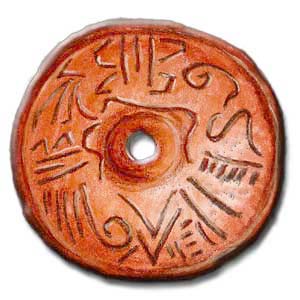

Particularly
intriguing are some inscriptions on the spindle whorls used in weaving.
The oldest date back seven thousand years. They are long, complex writings
that follow the circular movement of the tool. Weaving is generally
closely linked to myths and religious rites and the act of spinning
is full of allegorical and sacred force. It is thus difficult to esplain
these inscriptions with their practical use. Whorls are among the most
significant votive offerings found in cult centres and burial grounds.
The whorls rotate when in use, and it is thus possible that the geometric
motifs represent writing with cyclical, periodic features. Or are they
meant to be read by the faithful or the divinity as the whorl turns?
Is this a kind of prayer directed towards to the heavens like the Tibetan
prayer wheels?
(Merlini
2001)
What
is the appearance of the Balkan-Danube inscriptions? They have the most
varied patterns, in horizontal, vertical or circular rows. However this
variety is not prompted by an individual or random disposition, but
has an order: there is a specific sequence in the signs. In the majority
of cases, the writing had a linear organization, a feature it shares
with other pre-classic writings (Minoan Linear A, Cypriot-Minoan and
Cypriot Syllabic).
When the signs are grouped together (as in Uruk tablets 6000 years old)
they are accompanied by pictographs and ideograms. A linear organization
expresses a phonetic type of writing, since the graphic fixing of sound
sequences in the oral language takes place on a temporal line (i.e.
before or after). The linear organization of writing is however one
of the most controversial issues.
